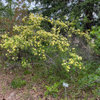What are these? Should I set them free or smush them?
sherryocala
14 years ago
Related Stories

MOST POPULAR4 Obstacles to Decluttering — and How to Beat Them
Letting go can be hard, but it puts you more in control of your home's stuff and style. See if any of these notions are holding you back
Full Story
DECORATING GUIDES11 Area Rug Rules and How to Break Them
How big should an area rug be? These guidelines will help you find the right size and placement
Full Story
ARCHITECTUREWorld of Design: 10 Homes That Lap Up the Landscape Around Them
As building techniques develop, architects all over the globe are finding new ways — and new places — to integrate houses with nature
Full Story
GREAT HOME PROJECTSPower to the People: Outlets Right Where You Want Them
No more crawling and craning. With outlets in furniture, drawers and cabinets, access to power has never been easier
Full Story
COLOR4 Cool Paint Colors Touted for 2014 — and How to Use Them
Muted but complex, these hues from Farrow & Ball can stand on their own or play supporting roles
Full Story
HOUSEKEEPINGWhat's That Sound? 9 Home Noises and How to Fix Them
Bumps and thumps might be driving you crazy, but they also might mean big trouble. We give you the lowdown and which pro to call for help
Full Story
DECORATING GUIDES7 Design Rules and Why You Should Break Them
Think tile is only for kitchens and bathrooms? Art should hang at eye level? Time to consider breaking these old rules
Full Story
DECORATING GUIDESTaste a Rainbow: 11 Top Home Decorating Colors and How to Use Them
Prime yourself for spring painting season with our color-happy guide to working with popular shades around the home
Full Story
MOVING5 Risks in Buying a Short-Sale Home — and How to Handle Them
Don’t let the lure of a great deal blind you to the hidden costs and issues in snagging a short-sale property
Full Story
LANDSCAPE DESIGNThe 7 Best Plant Types for Creating Privacy and How to Use Them
Follow these tips for using different kinds of plants as living privacy screens
Full Story










lucretia1
sherryocalaOriginal Author
Related Professionals
Eden Prairie Landscape Architects & Landscape Designers · Palm Springs Landscape Architects & Landscape Designers · Wheeling Landscape Architects & Landscape Designers · Woodinville Landscape Architects & Landscape Designers · Harvey Landscape Architects & Landscape Designers · Anderson Landscape Contractors · Goodyear Landscape Contractors · Lake Zurich Landscape Contractors · Quincy Landscape Contractors · San Pablo Landscape Contractors · Palos Verdes Estates Swimming Pool Builders · South Miami Heights Swimming Pool Builders · Fairfax Siding & Exteriors · Lenoir Siding & Exteriors · Marion Siding & Exteriorsmalcolm_manners
thonotorose
bellegallica
aliska12000
sherryocalaOriginal Author
malcolm_manners
sherryocalaOriginal Author
york_rose
gatormomx2
duchesse_nalabama
aliska12000
malcolm_manners
sherryocalaOriginal Author
malcolm_manners
jerijen
sherryocalaOriginal Author
michaelg
sherryocalaOriginal Author
paparoseman
jaxondel
malcolm_manners
sherryocalaOriginal Author
gatormomx2
ames_secret_garden
harryshoe zone6 eastern Pennsylvania
michaelg
sherryocalaOriginal Author
scox
maryann_va
sherryocalaOriginal Author
scox
poodlepup
york_rose
michaelg
york_rose
melissa_thefarm
york_rose